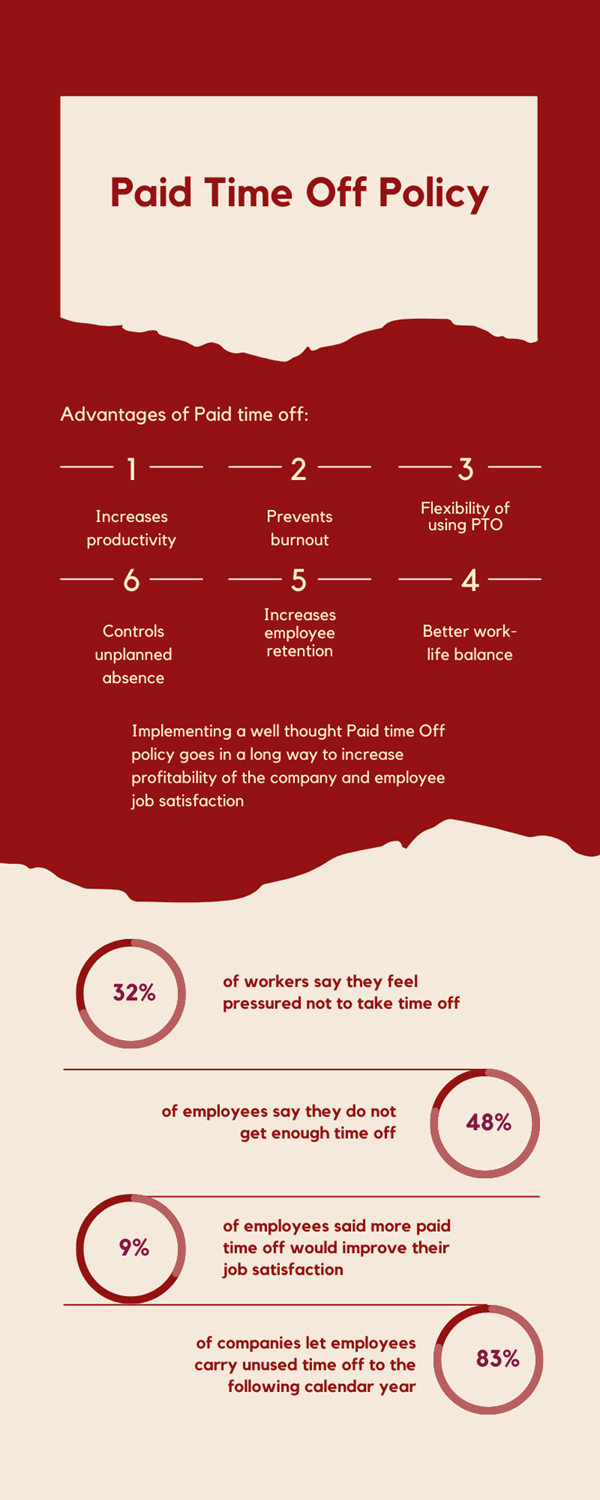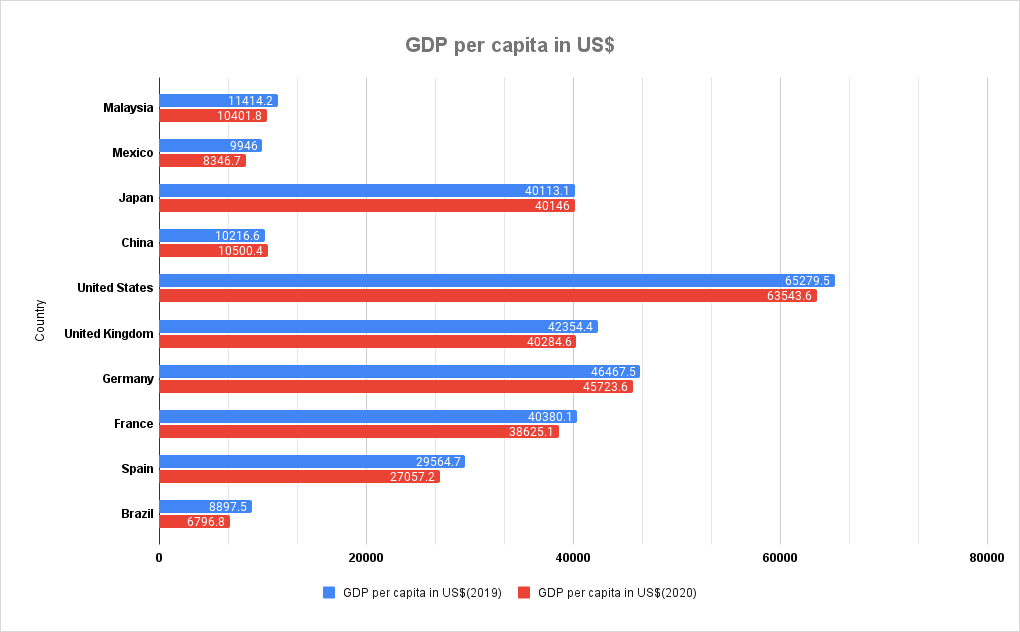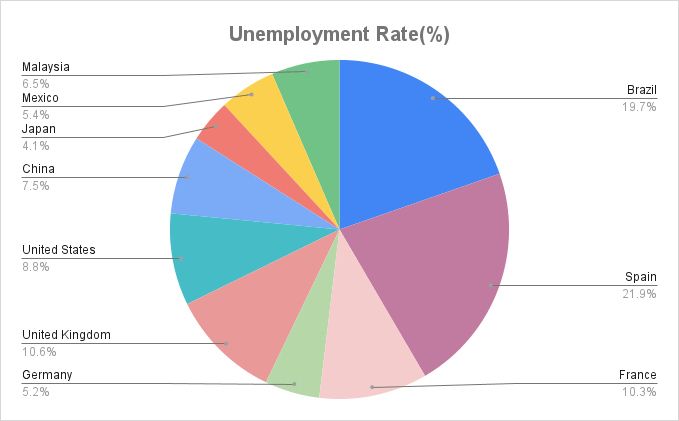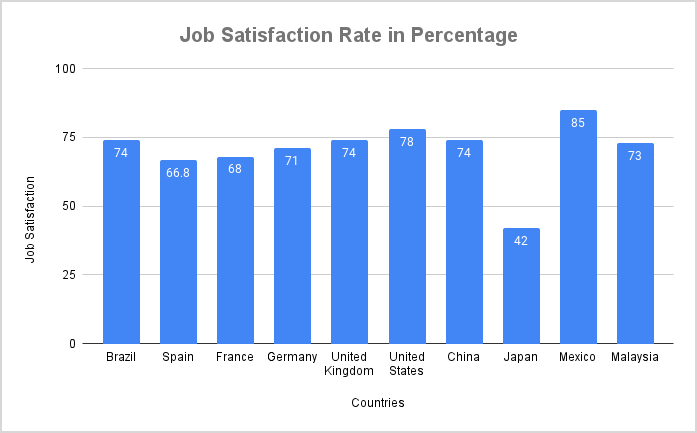Rest is not a luxury; it is a necessity. Take the time off to replenish your energy and recharge your soul.” – Dr. Lucas D. Shallua
Get an comprehensive overview of Paid time-off policies in various countries.
- What does Paid time off mean?
- History of Paid Time-Off
- How does the Paid time-off system works?
- PTO policy for Exempt and Non-Exempt employees
- What are the benefits of Paid time-off policy?
- Effect of PTO during Covid times
- Governments proposing new legislation on PTO
- What are the different Time-Off policies around the world?
- Statistics related to PTO
- Conclusion
What does Paid Time-Off mean?
A Paid Time Off is a benefit provided to an employee by the company for taking time off for specific number of days and still grant compensation.
The time offs taken can be personal time off, vacation leaves, sick leaves, leaves for medical reasons, or other purposes.

Every country has different time-off policies. In this article, we will learn more about time off policies in different countries, the history of PTO, whether PTO makes a difference in productivity, and some statistics.
History of Paid Time-Off
- Early US proposal:
- Over 100 years ago, President William Taft proposed 2-3 months of mandatory vacation for American workers, but this proposal did not become law.
- European leadership:
- Around the same time, Sweden and Germany enacted laws mandating seven weeks of annual paid leave.
- Early PTO adoption in the US:
- A 2010 WorldatWork study showed that 44% of surveyed US companies had PTO plans in place before 2000.
- Shift in PTO systems:
- In 2002, traditional segregated leave systems (vacation, sick leave) were more common (71%) than PTO banks (28%).
- By 2010, this trend reversed, with traditional systems at 54% and PTO banks at 40%, indicating a growing preference for consolidated leave.
- Challenges in large organizations:
- PTO bank systems were less common (32%) in very large companies (20,000+ employees) in 2010, compared to mid-sized companies (10,000-19,999 employees).
- US lag in paid leave mandates:
- Many European countries have long-standing laws mandating minimum paid vacation and holidays.
- The US has not implemented federal paid leave mandates.
- The Family and Medical Leave Act (FMLA) of 1993 guarantees 12 weeks of unpaid leave for family medical issues.
- Key contrast:
- The United states has focused on unpaid medical leave, where many European nations have focused on mandated paid leave.
How does the PTO system work?
The way it works in most companies are there are two kinds of PTO:
- Individual System
- Pooling System
Individual System:
In the individual system, the company grants a pool of leaves to all employees, including different kinds of leaves. The different types of leaves are vacation leaves, leaves taken for medical purposes, bereavement leave, leave taken for personal reasons, casual leave, study leave, paternity leave.
These leaves are differentiated into various categories and each employee is granted certain leave depending on the years of service in the company.
These leaves are credited based on the time they worked in a calendar year. For example, the company may give sick leave of 1.5 days per month of work done. These leaves are accrued and the employee can take these leaves when they feel unwell. Sometimes some of these leaves are carried over to the following year.
It depends on the employee on how they avail themselves of the PTO benefit. At the end of the year, the unutilized leaves are carried over to the following year, or the employees are paid for the unused time-offs. The company decides this carry-over or accrual policy on how much leaves can be accrued and how much can be paid off.
Pooling System:
The company grants a pool of leaves to a group of employees. This system allows employees to share their leaves with others.
PTO policy for Exempt and Non-Exempt employees:
Non-exempt employees have to be paid only for the hours they work, so they may take partial or complete unpaid time off whenever they are authorized.

If an exempt employee has a paid time off available, they can use it as and when required. This paid time off will not affect the employees’ compensation and also will safeguard the exempt status. But if the employee has exhausted all the time offs, then salary deductions are permissible without affecting the exemption.
What are the benefits of Paid time-off policy?

Effects on PTO during Covid times
Before the Covid-19 times, when people used to work fixed hours, PTO made lots of sense to balance family time, sickness, and other needs. With Covid-19 companies are changing the time off policies. Employees now work on flexible hours, and probably the PTO policies may not be the same as before.

So what changed? Companies are thinking about many changing circumstances such as:
- Some employees are facing disastrous situations when they directly or indirectly get affected by Covid-19. The PTO banking policy may help in this case.
- Companies are thinking more about the wellness of their employees. Unless good policies are in place, the turnover will increase. Employees can now work in any geographical location staying at home.
- Due to the changing conditions, some of the countries and states are putting new legislation.
Governments are proposing new legislation for PTO
Currently, there are no mandated paid leaves by the Federal Government. However, some states have created their own paid sick leave policy.
- United States: Differs from state to state, varies between 0 to 1 hour of sick leave per 30 hours worked.
- Sweden: 80% of the salary up to one year.
- Iceland: First 12 days 100% salary after that one year of paid leave every two years.
- Slovenia: Unlimited time off at 80% of their salary. If work-related, 100% of the salary.
- Lithuania: For 15 months at 62% salary.
- Hungary: First 15 days at 70% of salary after that varies between 50% to 62%.
- UK: From the third day onwards, employees are entitled to get fixed pay (on the average 20% of the salary) for up to 28 weeks.
- France: 90 days of paid sick leave at 50% salary or a fixed amount.
- China: Generally, 60 to 100 percent of their salary also depends on the seniority.
- Other Countries: At least 145 countries provide sick leaves, with 127 giving leave for a week or more annually.
What are the different Time Off Policies around the world?
5 Countries with Best Time-Off policies:
1. Brazil:
In Brazil, any employee has the right to 30 days of paid vacation per year. It has up to 12 paid public holidays in a year. Their length of annual leave depends on the number of days of absence from work. An employee gets:
- 30 days of annual paid leave if the worker was absent for no more than 5 days
- 24 annual paid leaves, if the worker was absent between 6 and 14 days.
- 18 annual paid leaves if the worker was absent between 15 and 23 days.
- 12 annual paid leaves if the worker was absent for no more than 24 and 32 days.
2. Spain:
Spain is generous in Annual or public holiday leaves. In Spain, employees are entitled to 22 days of annual leaves. In addition to this, there are 14 paid public holidays at the national, state, and local level.
Unlike other countries, employees do not get compensation financially for vacation days. The employees have to take leave as it accrues each year.
3. France:

Employees in France are entitled to paid leaves after one month of employment. Thus, they receive a total of 5 weeks of paid leave in a year and enjoy 11 paid public holidays a year.
4. Germany:
In Germany, employees are entitled to 20 days of paid annual leave. It also has 10 paid public holidays per year.
5. United Kingdom:
In the United Kingdom, employees are entitled to 5.6 weeks(28 days) of annual leaves. In this, 20 days are paid yearly leaves, and 8 are paid public holidays. If holidays aren’t used in the UK, the employers are entitled to pay for the days not taken off.
5 Countries with Worst Time-off policies:
1. United States:

The United States is the only country with no minimum paid vacation or paid public holidays.
According to the US Bureau of Labor Statistics, 77% of private employers offer paid time off to their employees – on average, 10 paid annual leaves per year after one year of service and 8 paid public holidays per year. However, some employers offer no vacation at all.
The average paid vacation day offered by private employers is:
- 10 days after 1 year of service
- 15 days after 5 years of service
- 17 days after 10 years of service
- 20 days after 20 years of service
2. China:
China offers annual paid leaves to employees after one year of employment. It offers:
- 5 days of annual leave to employees who have worked for 1-10 years.
- 10 days of annual leave to employees who have worked for 10-20 years
- 15 days of annual leave to employees who have worked for more than 20 years.
Workers do enjoy 11 paid public holidays.
3. Japan:
Japan offers 10 days of paid leave after 6 months of service. The vacation days increase as you stay longer in a company.
- 11 days of annual leave for employees who have worked for 1 year and 6 months.
- 12 days of annual leave for employees who have worked for 2 years and 6 months.
- 14 days of annual leave for employees who have worked for 3 years and 6 months.
- 16 days of annual leave for employees who have worked for 4 years and 6 months.
- 18 days of annual leave for employees who have worked for 5 years and 6 months.
- 20 days of annual leave for employees who have worked for 6 years and 6 months.
4. Mexico:
Mexico offers 6 annual paid leaves to their employees after one year of service. This duration increases by 2 working days(maximum up to 12 days) for each subsequent year of service. After the fourth year, the vacation period shall increase by 2 days for every five years of service.
Employees also enjoy 7 paid public holidays.
5. Malaysia:
Malaysia offers 8 days of annual leave for the first 2 years of service, and it increases to 12 days per year for 2 and 5 years of service and 16 days per year for 5 or more years of service.
Employees are entitled to receive 11 paid public holidays.
Statistics related to PTO:
GPD chart for the countries mentioned above:

As we see here, United States has a no PTO policy, inspite of that, the GDP per capita is the highest. In 2019 it was 65279.5, whereas, in 2020, it was 63543.6. After the United States, Germany showed a good GDP per capita of 46467.5 in 2019 and 45723.6 in 2020.
In comparison to the countries mentioned above, Brazil has low GDP per capita. For example, in 2019, it was 8897.5, whereas, in 2020, it was 6796.8. After Brazil, Mexico showed a low GDP per capita of 9946 in 2019 and 8346.7 in 2020.
Unemployment Rate:

The unemployment rate is highest in Spain and Brazil, and comparatively, Japan and Germany are on the lower side.
Job Satisfaction Rate:

Mexico has the highest job satisfaction rate. The factors contributing to job satisfaction are job security, high income, opportunities for advancement, work timings.
The United States also has a reasonable employee job satisfaction rate. The reasons are their job security, financial aspects, benefits provided to them, and other things like work environment, coworkers, supervisors, acknowledgment, etc.
Japanese are the least satisfied amongst all. Only 42% of employees are happy with their work. As per the survey , the lousy work environment contributes to unhappiness. A new law that went into effect in the country aims to protect workers from abuse and bullying. They are also least likely to expect a bonus or pay rise.
- 81% of employers that offer benefits agree that their company’s benefits offerings increase employee satisfaction.
- 9% of employees said more paid time off would most improve their job satisfaction.
- 79% of employees leaving their current job due to poor company culture say that paid time off is very important in their next job.
All the above survey shows that it is essential for a company to think about the well-being of their employees. Addressing issues like burnout, mental health, and job satisfaction rate, will help improve productivity and retention.
Annual average working hours of different countries (2020 data):
| Countries | Average Annual working hours (2020 data) |
| Brazil | 1709.49 |
| Spain | 1577 |
| France | 1402 |
| Germany | 1332 |
| United Kingdom | 1367 |
| United States | 1767 |
| China | 2174.5 |
| Japan | 1598 |
| Mexico | 2124 |
| Malaysia | 2238.27 |
The above table indicates that Malaysia and China have the highest average annual work hours. The number of time offs given in these two countries is also the lowest.
Long working hours are common in China. As a result, their schedule is referred to as 9-9-6, a shorthand for a 72-hour workweek, from 9 a.m. to 9 p.m., six days a week.
Malaysia has also recorded longer working hours with an average of 12 hours over their contracted hours. These long working hours have a detrimental effect on the employees’ work-life balance. As per the survey conducted by MIMS, 26.5% of doctors have admitted that they were involved in a motor vehicle accident after working for long hours, 56.1% of doctors and 61.4% of pharmacists have stated that they made a medical error due to mental stress after working for long hours.
Countries with long working hours are also those with the highest percentage of productivity loss. Employees are facing burnout issues due to exhaustion. The employees are unproductive despite being present at work due to high levels of depression, lack of sleep, stress, and poor health.
Comparatively, the average annual working hours in Germany are less. The legal framework in Germany says that – “a workweek may not exceed 48 hours a week or 8 hours a day over an average period of 6 months”. Thus, Germany strikes a balance between work and life. Their productivity is at a high level, and employees find a well-deserved life balance.
Conclusion:
A well thought time-off policy for employees is an excellent contribution towards employee welfare.
Take a look at the Free OfficeClip Time Off application which will manage all the records of your employee’s time offs and make payroll processing an easy job. In addition, it will help manage the leaves with different categories with various accrual policies.

